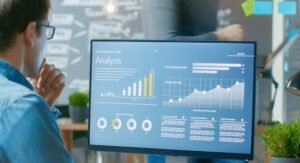Last updated on April 4th, 2024 at 11:00 am
Reading Time: 6 minutesAccurate forecasting is crucial for organisations to stay ahead of the competition in the quickly changing business world of today. Significant insights that can inform strategic decision-making and help firms adapt to changing market conditions can be found by analysing and interpreting large amounts of data. Here, forecasting—the process of predicting future patterns and outcomes using data analytic techniques—comes into play.
We’ll delve thoroughly into the fascinating topic of forecasting in this article. You’re in the proper place regardless of your level of forecasting expertise or experience. We would like to impart some insightful knowledge to you before you enrol in a business analytics course. So let’s get started now!
What is Forecasting?

In order to produce educated predictions regarding future trends, forecasting is a widely employed strategy in the business sector. By assigning budgets and foreseeing expenses based on expected demand for goods and services, this method aids organisations in planning ahead. Businesses can improve their overall strategic planning and make better judgements by using forecasting. In order to support an organisation’s long-term growth and success,a BBA business analytics course can be extremely important.
Quantitative Techniques in Business Forecasting
Using quantifiable information like statistics and past data, quantitative forecasting focuses on projecting future patterns over the long term. This method can produce more precise forecasts about the future by analysing historical performance to find trends and rates of change. Businesses particularly benefit from this kind of forecasting because it gives them the ability to more accurately predict future demand for their products and services, helping long-term planning. Several of the most popular quantitative models that you may learn in a business analytics course are as follows:
Trend Analysis Method:
The Trend Analysis Method, also referred to as “Time Series Analysis,” is a widely used forecasting technique that relies on past data to predict future events. This method excludes outliers and gives greater weight to more recent data, making it particularly effective when there is a substantial amount of historical data demonstrating clear and stable trends. Due to its cost-effectiveness and reliability, it is considered the most common forecasting method used by businesses.
Econometric Modelling:
In order to evaluate data consistency over time and relationship significance, econometric modelling employs several regression models. It helps in foreseeing important economic changes and how they will affect a company. By using this strategy to analyse past data, businesses may make wise decisions.
Indicator Approach:
The Indicator Approach utilises leading indicators to estimate the performance of lagging indicators by examining their relationship. Lagging indicators are a type of KPI that measures business performance after the fact, offering insights into how business strategies have impacted results.
Qualitative Modelling Methods
In order to evaluate data consistency over time and relationship significance, econometric modelling employs several regression models. It helps in foreseeing important economic changes and how they will affect a company. By using this strategy to analyse past data, businesses may make wise decisions.
Market Research Model:
The market research approach calls for performing in-depth market research, which includes asking a wide range of questions of both present and potential customers as well as staff members to gain their feedback. By examining the attitude of their target market, businesses can predict the results of the introduction of a new product. This method aids in marketing success and corporate strategic direction.
Delphi Model:
A common tactic is to put together a group of specialists and request their input on a certain topic. After reviewing these estimates, businesses can provide an objective evaluation. This strategy can provide illuminating data and aid in guiding decision-making for a range of business-related challenges.
Components of a Business Forecasting System
Forecasts are utilised by businesses to formulate their strategies and plans. Engaging in business forecasting itself can facilitate proactive thinking and preparation for what lies ahead. Therefore, it holds immense significance in predicting and planning for the future. James W. Redfield has outlined the essential components of the forecasting procedure as follows:
Preparation of the Groundwork:
Before starting any procedure, it is essential to conduct in-depth research about the company you are working with, the services they offer, and the industry they serve. This means closely analysing both their past success and their prospects for future development. It’s a crucial phase, therefore you shouldn’t skip it!
Establishment of the future business:
When a company is predicting the future, looking at the data and feedback from the past might assist uncover prospective outcomes. It’s important to keep in mind that the organisation’s senior leaders provide this data, therefore they must be included in the process. As the ones ultimately in charge of ensuring that the forecasts are met, their involvement is crucial to producing an accurate projection.
Comparing the actual and estimated result:
When businesses do forecasting over a period of time, it sets a benchmark for what they expect to happen. Later, when they compare those forecasts to the actual outcomes and growth, it can help them investigate and analyse any deviations. This is especially important if there are big differences between the two. By doing this, businesses can better understand why things didn’t turn out as expected and make adjustments for the future.
Refining the Forecast process:
Once the management team becomes more adept at using forecasting to predict the future of their company, they can improve their forecasts to make them more accurate. In the event that the circumstances alter while they are evaluating, they can do this by adding new variables to their estimates. In this manner, they are able to change with the situation and make sure their forecasts are as precise as possible. Learning as they move along and constant development are key!
Selecting the Best Forecasting Technique
The best forecasting approach will vary depending on the specifics of the forecast you’re doing. The forecasting approach you use depends on the kind and extent of your forecast. There are various forecasting approaches.
An approach for predicting known as qualitative techniques is renowned for its excellent accuracy. When the forecasting window is small, such as when attempting to predict how the public will respond to a new product, it is frequently utilised. Businesses can use these methods to strengthen their product decisions by taking into account aspects like client preferences and feedback. As a result, businesses may be able to better tailor their offerings to the needs and preferences of their target market.
When companies need to swiftly assess a larger variety of data, they commonly use quantitative forecasting approaches. These methods investigate enormous data sets using statistical software programmes in a matter of minutes or seconds. However, the amount and complexity of the data that needs to be analysed can affect the cost of the analysis.
Because of this, forecasters frequently have to balance the benefits and drawbacks of each technique to decide which will produce the best accurate forecast in the shortest amount of time. In some cases, it might even be advantageous to mix various techniques to increase the forecast’s dependability. Finding the ideal balance between cost and precision is crucial!
Benefits of Business Forecasting System
Your organisation can profit greatly from having a business forecasting system. It can, for one, assist you in developing data-driven plans and in making educated judgements. You can base financial and operational choices on the state of the market at the time and projections of what the future will bring with a strong forecast.
One of the best things about forecasting is that it enables you to take a proactive rather than a reactive approach. You can set up your business to take advantage of fresh opportunities or reduce hazards before they become serious problems by anticipating prospective market developments. This might assist you in maintaining a competitive edge in your sector and staying one step ahead of the competition.
Limitations of Forecasting
Because forecasting involves speculating about the future, which is inherently uncertain, this is its main drawback. Forecasts are therefore just educated guesses. The underlying assumptions and data utilised in the models must be accurate, even if there are many ways to improve forecast accuracy.
In essence, forecasting’s primary difficulty is that it requires making predictions based on incomplete data. There will always be some degree of uncertainty and risk involved, even though we may use statistical techniques and other tools to increase the accuracy of our forecasts. In the end, we can only make the best predictions we can based on the data we have available.
Conclusion
Are you ready to improve forecasting inside your company and provide more accurate predictions? To be successful, forecasting methodologies must be used correctly and combined with the management team’s knowledge.
The effectiveness of your forecasting process depends on this partnership. Imarticus Learning’s certified BBA Business Analytics course can be of interest to you if you’re trying to improve your knowledge and abilities in forecasting with data in business.

